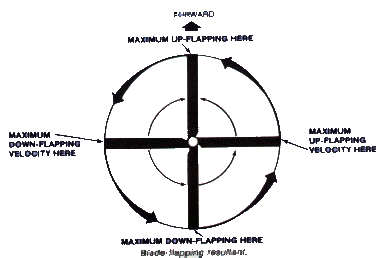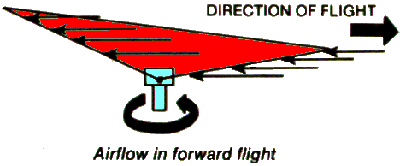

Blade Flapping is the up and down movement of a rotor blade, which, in conjunction with cyclic feathering, causes Dissymmetry of Lift to be eliminated.
The advancing blade, upon meeting the progressively highter airspeeds brought about by the addition of forward flight velocity to the rotational airspeed (of the rotor), responds to the increase of speed by producing more lift.
The blade flaps (or climbs) upward, and the change in relative wind and angle of attack reduces the amount that would have been generated.

In the case of the retreating blade, the opposite is true:

As it loses airspeed, reducing lift causes it to flap down (or settle), thus changing its relative wind and angle of attack. The resulting larger angle of attack retains the lift that would have been lost because of the reduced airspeed.
The flapping velocities are at maximum values directly over the right and left sides of the helicopter, because at those locations the airspeed differential is at its maximum. In the study of cyclic pitch, in a dynamic system such as a main rotor system with intertia, there is a phase angle between the maximum applied force and the maximum displacement. The force-displacement phase is 90 degrees, and is not affected by blade mass or any kind of air dampening. It then follows that if the maximum upward and flapping velocity is directly over the right side of the helicopter, the maximum displacement or actual flapping will take place over the nose of the aircraft. Conversely, if the maximum downward flapping velocity is directly over the left side of the helicopter, the maximum displacement or actual flapping will take place over the tail of the aircraft. The following graphic illustrates this relationship:Flapping Velocity
Flapping Velocity, both upward and downward, must be of such a value as to increase or decrease the angle of attack so that the lift will remain constant. It is understandable that the maximum upward flapping velocity will take place directly over the right side of the helicopter, and the maximum downward flapping velocity takes place directly over the left side of the helicopter. (This discussion assumes counterclockwise blade rotation, for clockwise rotation, they are reversed)

The total result of this action is a rotor tilt to the rear which is completely independant of any additional cyclic stick action and which causes an angular separation between the control axis and the thrust axis of the rotor.
There is yet another periodic force with a phase-displacement angular separation of 90 degrees. This one arises from periodic longitudinal forces which result from rotor coning while the helicopter is in directional flight and causes the rotor to tilt to the side.

From the above graphic it may be seen that the relitive wind created by the helicopter's forward flight causes angle of attack differences between the front and rear of the rotor. The blade over the nose of the helicopter experiences an increase in angle of attack because the aircraft relative wind approaches the blade level with or below its span. The blade over the rear of the helicopter experiences a reduced angle of attack because the aircraft relative wind approaches it from above.

The above graphic shows that the higher angle of attack at the front of the rotor will cause the blade to flap up over the left side of the helicopter. The lower angle of attack over the rear of the rotor will cause the blade to flap down over the right side. The rotor will thus be tilted a little to the right. the sideward tilt of the rotor is increased at low forward speeds when the induced velocities are large, because the inflow not only approaches the rear of the rotor but, additionally, is bent downward. this increases the angle of attack differences.
 Return to Dynamic Aerodynamics!
Return to Dynamic Aerodynamics!
 Return to Dynamic Flight
Return to Dynamic Flight
Copyright ©1999-2017 Dynamic Flight, Inc. All rights reserved.
Page Last Updated on: Nov-06-2017